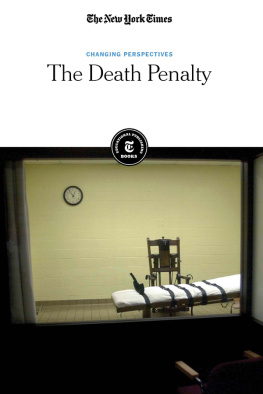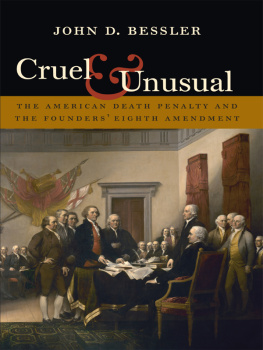Cruel and Unusual
The Supreme Court and Capital Punishment
Michael Meltsner

Quid Pro Books
New Orleans, Louisiana
Preferring to present the legal landscapeas it was during the years described, the author has made noattempt to update changes in law and practice following publicationof the first edition.
CRUEL AND UNUSUAL
Copyright 1973, 2011 by Michael Meltsner.All rights reserved. Foreword copyright 2011 by Evan J.Mandery.
Previously published in 1973 by Random House,Inc., New York, New York.
Published in 2011 by Quid Pro Books, atSmashwords.
Quid Pro, LLC
5860 Citrus Blvd. D-101
New Orleans, LA 70123
www.quidprobooks.com
Publishers Cataloging-in-Publication
Meltsner, Michael.
Cruel and unusual: the Supreme Court andcapital punishment / Michael Meltsner.
p. cm.
Includes bibliographical references andindex.
Series: Legal History &Biography.
ISBN: 1610270975 (ePub)
ISBN-13: 9781610270977 (ePub)
1. Capital punishmentUnited States. 2.United States. Supreme Court. I. Title. II. Series.
KF227.C2M4 2011
345'-2011'077 2011-3990
Excerpt from On Violence and Legitimacy,by Wilson Carey McWilliams, reprinted by permission of The Yale LawSchool Journal Company and Fred B. Rothman & Company from TheYale Law Journal, Vol. 79, p. 627.
Excerpt from the article Death by Degrees,by Robert Lee Massie, reprinted by permission of Esquire magazine.Copyright 1971 by Esquire, Inc.
Cover image adapted from a photograph byScott Langley , reproduced under license withwww.deathpenaltyphoto.org and the Death Penalty PhotographyProject. It depicts Old Sparky, a common electric chairpreviously used in Texas and now on display at the Texas PrisonMuseum in Huntsville. Copyright by Scott Langley.
License Notes, Smashwords edition: This ebook islicensed for your personal use only. This ebook may not be resoldor given away to other people. If you would like to share this bookwith another person, please purchase an additional copy for eachperson. Thank you for respecting the hard work of theauthor.
To Heli
But faced collectively and in action,
death changes its countenance; now
nothing seems more likely to intensify
our vitality than its proximity.
Hannah Arendt, On Violence
Contents
Foreword, 2011
13 If the Death Penalty Is to Be Retainedat All
FOREWORD
On May 25, 1961, President John Kennedy askeda special joint session of Congress to commit itself to landing aman on the moon by the end of the decade. It was an expensive andaudacious proposal. Kennedy estimated that the project would costbetween $7 and $9 billion, or almost $50 billion in currentdollars. (In fact it cost three times that.) Money aside, peopledidnt think America could do it. Four years after Sputnik, NASAstill lagged far behind its Soviet counterpart. The first twoProject Vanguard launch attempts had been spectacular, highlypublicized failures. Many politicians ridiculed Kennedys proposalas a huge, wasteful spending scheme. Of course, on July 20, 1969,Kennedys supporters in the space program had the last laugh.
In early 1963, lawyers for the NAACP LegalDefense Fund advanced their own audacious proposal. On a finespring day, Michael Meltsner and two of his LDF colleagues, FrankHeffron and Leroy Clark, sat on the lawn of Central Park, and overtake-out deli sandwiches decided to end the death penalty inAmerica. Less fanfare attended this event than did PresidentKennedys speech, but Meltsner and his colleagues proposal was inmany respects more ambitious. Prior to Justice Arthur Goldbergsdissent from the denial of certiorari in a case called Rudolphv. Alabama, no lawyer had seriously advanced the idea that thedeath penalty was unconstitutional. This would be an uphillbattle.
Meltsners proposal embraced a vision of arace-blind and humane society, and harkened to the sameaspirational spirit as did President Kennedy. And, like Kennedy,Meltsner would succeed. On June 29, 1972, the Supreme Court ruledcapital punishment as then practiced unconstitutional under theEighth Amendment. The decision would be emblazoned across the frontpage of The New York Times in a six-column headline, theboldest since man landed on the moon. The similarities betweenthese ventures cannot be ignored. Even their timetables weresimilar. Kennedys vision took eight years and two months to reachfruition. Meltsners took almost exactly one year longer.
In these pages you will read the rivetingstory of how Professor Meltsners daring and subversive ideaadvanced from a picnic blanket to the highest court in the land. Itis an extraordinary tale, with appropriately extraordinarycharacters, including Anthony Amsterdam, debatably the mostimportant lawyer of the twentieth century, but undeniably its mostcolorful. It is Meltsners vision to go to the moon, but it isAmsterdam who gets them there by his supreme intelligence andsuperhuman work ethic. He is a character you will not forget. Andwhatever your views on capital punishment, you will share his andhis colleagues joy, as they danced through the night following theCourts announcement in Furman v. Georgia of the end of thedeath penalty.
While this book has a happy ending, thepostscript is more of a mixed bag. In the three years followingFurman, 35 states and the federal government reauthorizedthe death penalty either by making it mandatory or by creatingstandards to govern jury deliberations. In 1976, the issue returnedto the Supreme Court, which upheld the constitutionality of the newguided-discretion statutes in Gregg v. Georgia. This was ahuge setback for the abolition movement and for LDF, whichrepresented Troy Gregg.
On the same day, however, LDF prevailed inWoodson v. North Carolina, in which the Court struck downmandatory death penalty statutes because they failed to treatdefendants as individuals. The following year, LDF won again inCoker v. Georgia, ruling unconstitutional the death penaltyfor adult rapists. These victories became the basis for the nextfour decades of death penalty litigation successes. Woodsonled the Supreme Court to substantially expand the right of adefendant facing execution to offer mitigating evidence on his orher own behalf. Coker led the Court to strike down the deathpenalty for other classes of crimes and criminals, includingcertain felony-murderers, juveniles, the retarded, and theinsane.
Because of the unfavorable decision inGregg, some observers have criticized LDFs efforts. Itseems impossible to question the response that defendants facingthe death penalty are far better off than they would have been hadLDF not become involved in 1963. But even for those less charitablyinclined to LDFs work, what a gift Cruel and Unusual is. Inthese pages, Meltsner lays bare every aspect of his and hiscolleagues thinking. You will read how they handicapped theirchances, which arguments they thought would work (you may besurprised), and what they thought of the Supreme Court justices whowould decide the crucial cases. You will come to understand whatthey perceived to be the basis for support for the death penalty,and, with Meltsners unflinching honesty, what they perceived to bethe inconsistencies in their position.
It is my odd lot in life to have read almostevery major book ever written about the death penalty in America.This is the best and the most important. Every serious scholar whowants to advance an argument about capital punishment in the UnitedStates whether it is abolitionist or in favor of the deathpenalty, or merely a tactical assessment cites this book. It isopen and supremely accessible.









